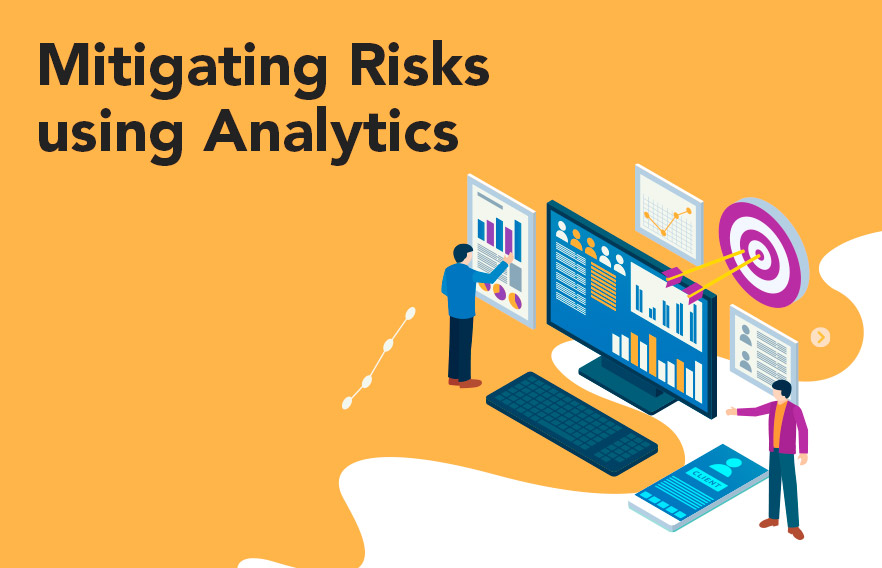Risks are very common in our day to day life, given that we deal with very sensitive situations around us. A lot of us take risks to achieve a target in life but can reduce those risks. Is there something out in the world that will help us see/envision what could be the outcome without taking the risk and facing an unfavorable outcome. Fortunately, we are gifted with the power of analytics to see/forecast how the risk might turn out to be.

Is there a savior to end all our risks?
Using the broad aspect of Predictive Analytics, risks are reduced in all aspects of an organization that collects data in some form. Historical data is the backbone of predictive analytics and an essential requirement for identifying and reducing risks. So how did historical data and reducing risks become a match made in heaven? This amazing match can be corroborated using multiple analyses such as trend analysis, descriptive analysis, Diagnostic Analytics, and Prescriptive Analytics, etc.
Diagnostic Analytics – By combining multiple reports, we can identify trends and discover relationships that are related to the analysis at hand. In finding these relationships, we can also check for untimely spikes and dips. These unrelated relationships will provide insights by which enterprises can prevent future issues that can turn out to be catastrophic.
Prescriptive Analytics – Prediction is almost a way of the future. Owing to that, we are enriched with enormous amounts of data from every industry. Using historical data to build models by utilizing the right metrics that define your business in order to predict what the potential outcome would be is a game-changer in terms of mitigating risks. This, in turn, will reduce the Total Cost of Risk by using the model’s prediction to make accurate business decisions.
Are you losing customers?
If enterprises don’t track how customers have been behaving towards their business over time, it is quite obvious that in due time, the customer churn rate will hit the roof. To avoid such disastrous situations that could topple the enterprise, statistical analysis can be leveraged to understand how consumers behave towards their business. This analysis will help in identifying where the interest lies, thereby shifting business ideas towards catering consumer needs, which will help in tying existing customers to an enterprise and also spark interest in potential customers.
Is your business location not the right choice?
In the current world, one of the major decisions while setting up a business is, ‘Where do we place it/build the HQ? It sure is a boggling question that requires deep levels of analysis to choose the right spot. To choose the right location, several metrics need to be looked at such as ‘Are there any competitors around?’, ‘What’s the area population?’, ‘Is the place resourceful enough for the business needs?’, ‘How’s the crowd mentality towards their industry?’, ‘Will their employees benefit from this location?’, etc. are some of the many questions that need to be answered before zeroing in on a location.
Why is this so important? A wrong decision can lead to the downfall of an enterprise because they didn’t know enough about how location can impact their business. It is very risky to not consider this because a lot of time, money, and work would have gone into it. By using firmographics data such as information about the area, government data that includes the type of population, etc., provide impactful insights on how we can approach this problem of choosing a location. Hence, performing a thorough analysis using all possible metrics can show multiple possibilities for solving this issue.
Moving forward into a cyber world where the risks and concerns are growing ten-fold every day, Ernst and Young conducted a survey to find which was the most frequent cyber risk that enterprises were exposed to. This survey was rolled out to 665 companies that included both mid and large size. Cyber Breaches and Insider Threats were identified as the highest risk by those surveyed. Cyber Breach refers to unauthorized access to information/data by hackers, whereas Insider Threats are harmful threats that arise from people within the organization, such as employees or business associates. 62% of the respondents agreed that the above-mentioned risks are increasing every year.
These cyber-threats were followed by bribery and corruption, which amounted to 44%, and notably, the risk of financial statement fraud has increased over the years, with 26% of the respondents choosing this as another form of risk.
Here’s the survey report of Ernst and Young showing the % split of which risk is most prevailing in the industry

Some of the best practices to reduce insider-threats and cyber breaches are as follows:
- UAM or User Activity Monitoring
Collecting real-time user activity data of employees such as downloads, uploads, and emails sent/received. This can be combined with a Security Information and Event management system, which allows the system to notify the administrator in the event of any abnormal activity
- Educate Employees
Employees must be updated with current data security policies through classroom sessions and quizzes. Interactive webinars and conferences based on Security can be made available to employees.
- Reviewing User Privileges
Organizations must inculcate the process of reviewing user privileges to all kinds of data and information periodically to make sure there has been no breach, and employees are made aware of their rights to information.
Managing data for analytics is a specialized field and a topic for another day. But the business that can effectively leverage data and analytics to manage the risks it faces will be rewarded by seeing the future more clearly, making better decisions, and ultimately being more successful.



